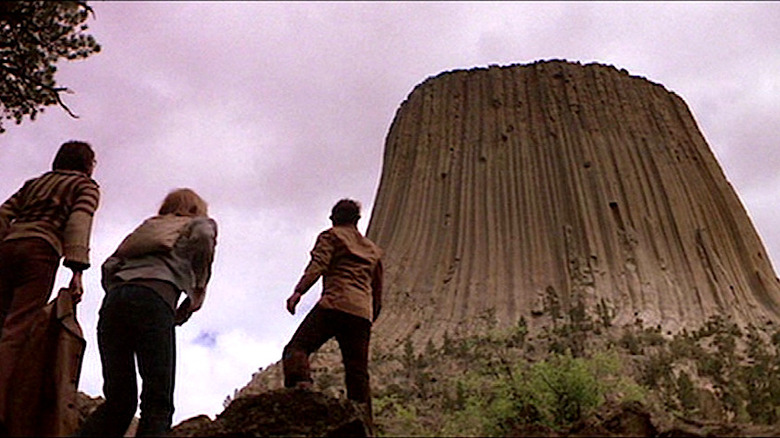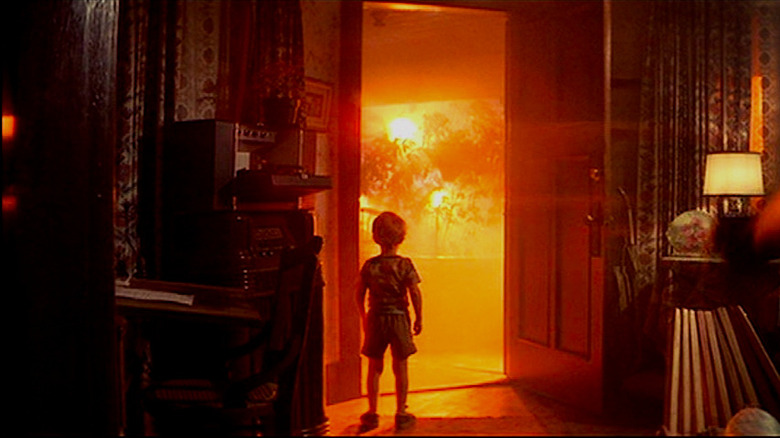Close Encounters Of The Third Kind Ending Explained: This Means Something, This Is Important
There are a lot of songs that can get stuck in your head — Disney's "It's a Small World" song, that catchy Oscar Mayer Wiener jingle, Eiffel 65's bop of a hit, "Blue" — but none are as strange or as potent as the five-tone melody from "Close Encounters of the Third Kind." It's such a delightful little ear worm that when you watch the film, you half expect Francis Bourgeois, TikTok's beloved trainspotter, to come running into the frame screaming about tones. For Roy Neary (Richard Dreyfuss), the tones are equally as enticing to him the first time he hears them. After all, this is a movie about a man whose obsession with aliens nearly ruins his life.
Steven Spielberg's 1977 alien flick "Close Encounters of the Third Kind" tells the story of Neary, a local electrician who happens upon a UFO sighting by chance. His "close encounter" inspires him so much that he's thrust into disputable madness as he tries to uncover the mystery of visions that manifest in his head after seeing that unidentified spacecraft. Of course, his obsession begins to eat away at the relationships in his life, and eventually his wife Ronnie (Teri Garr) ends up leaving him and taking their children with her. What would you do if your husband started building to-scale models of the same mountain over and over again, even in his mashed potatoes?
Eventually, because this is a movie, Neary's obsession is revealed to have real significance as he bands together with a handful of other believers (you can always find at least one, amirite?) to make a pilgrimage to Devil's Tower (mashed potato mountain) to meet the aliens for himself. Of course, in the final scenes, the government and a whole host of believers and their families show up to be entranced by the mysterious alien beings in their neon spacecraft. No one seems to be as scared as they probably should be. Thankfully for them, the aliens are pretty damn peaceful, and without much discussion (and there probably should have been some kind of discussion), it's decided that Neary will accompany the aliens onto their mothership to apparently learn the secrets of the universe. Sorry, kids! Daddy's gotta get probed!
The movie ends with minimal kerfuffle, and the aliens never once seem to want to harm anyone. In fact, overall, "Close Encounters" is a pretty anti-climactic movie which begs the question, "What does it all mean?"
Spielberg has been fascinated by aliens since childhood
To understand the film's peaceful ending, you first have to understand Spielberg's obsession with extraterrestrial phenomena and the people who believe in it. The inspiration for "Close Encounters" came from a childhood experience with Spielberg's father, who took his young son to watch a meteor shower one night. Apparently, Spielberg was so moved by this celestial event that it enticed his imagination about space and the beyond, and it stuck with him for years to come.
In a director's statement for a screening of "Close Encounters" at the Venice Film Festival in 2017, Spielberg said, "I was a real UFO devotee in the 1970s, and really into the UFO phenomenon from reading. For me, it was science." In fact, his first film "Firelight," that was made when he was only 18 years old, was Spielberg's first foray into the alien world proving that his love of the unknown started at a young age.
In a 1977 interview for BFI, Spielberg talked about his interest in alien believers which was a big influence behind his desire to make "Close Encounters." In the interview, he said,
"People are always looking for – I don't know what you'd call it – I guess, the cosmic entertainment. More than the meteorological explanation. From the behavioral science point of view, I was just as interested in finding out why people looked to the skies, and want to believe, as I was in looking to the skies myself, to try to understand what's happening up there, that the Air Force and the Government don't want to tell us about.
He describes the "compendium of research" he completed and how he "was mainly inspired when I began to meet people who had had experiences, and I realized that just about every fifth person I talked to had looked up at the sky at some point in their lives and seen something that was not easy to explain." This desire to connect with and understand the alien believers is what fuels "Close Encounters," and it's ultimately what forms the movie's main message.
In the end it's all about communication, baby
When "Close Encounters" was made, aliens in film were nothing new, but depictions of extraterrestrial life didn't often paint them in the purest of lights. Aliens were always something to fear. They were impossible to communicate with, making them easy to depict as nefarious creatures intent on ruining humanity. "Close Encounters" changes this depiction with aliens that seem less interested in harming humans and more interested in pure contact and understanding.
While there are moments of suspense in "Close Encounters" and moments where you wonder about the aliens' intentions, the extraterrestrials never harm any of the humans they encounter. In fact, they seem just as fascinated with Neary as Neary is with them. Instead of violence, the creatures seek to communicate with humanity (enter the five-tone signal). This communication attempt bridges the gap between the two sides and creates an example of how connection is more powerful than distrust. In the movie's final scenes, when Neary is chosen to accompany the aliens onto their spaceship, we understand this as both humans and aliens attempting to create a connection with each other, one that's built on trust and a desire to understand.
It's vital that Neary board the mothership willingly and with confidence, and we, as the viewers, must also believe that he's making a safe and smart decision to join them. Our faith in this new partnership is enhanced by the fact that the aliens' previous human abductees have all been returned to Earth safely and without harm. They haven't even aged. It's clear to us then that the aliens mean mankind no harm, and if we trust them, we might just be gifted with new understandings about life, the universe, and everything.
Like most Spielberg films, there is a sense of wonder in how the characters interact with the aliens, and this wonder seems to be Spielberg's exact point. Instead of looking upon what we don't understand with fear, we need to recalibrate our reaction to one of curiosity and awe. Only then will we be able to move forward into new and exciting possibilities. "Close Encounters of the Third Kind" is not just a movie about alien encounters. It's a movie that seeks to highlight the importance of peaceful communication with those we do not yet understand.


